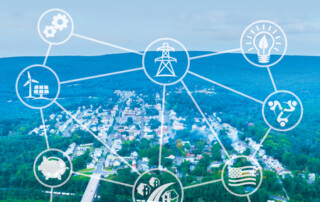
A Call to Action
Since its inception in 2007, the Presidential Climate Action (PCAP) has worked with America’s most distinguished thought leaders to develop ideas for America’s presidents to confront global climate change and the nation’s transition to clean energy.
Most recently, PCAP has focused on the inexorable link between global climate change and democracy. The connection is clear:
- Fossil fuels are the principal cause of global warming.
- The fossil energy industry uses its money and influence to keep governments from addressing climate change.
- Only the power of the people can break its grip.
Currently, 123 members of Congress publicly reject climate science. One of the two major party candidates for president calls global warming a “hoax.” And while the federal government is implementing the largest investment in clean energy in the nation’s history, opponents in Congress are attempting to repeal the law authorizing these investments.
In advance of the 2024 election, PCAP has collaborated with many of America’s most respected writers, scientists, former government officials, and others to issue a call to action – a statement signed by more than 160 leaders who point out that America needs a robust democracy to confront the growing climate crisis, and that left unaddressed, climate change will threaten democracy with impacts that put impossible pressures on its institutions.
Be part of this movement. Read the statement, see who has signed it, and add your signature at saving-democracy.net. Your support is crucial in our fight against climate change and for the preservation of democracy.
The Presidential Climate Action Plan has assembled several of the roadmaps governments and stakeholders have created in recent years for the world to achieve a net-zero energy economy by 2050 – a key goal of the Paris climate accord. Each entry includes hyperlinks to the full documents shown here. Overall, this roadmap library illustrates there are plausible paths to a cleaner and more stable future, if we have the political will to embark on them. PCAP will continue expanding the list to include other existing and newly released roadmaps.
Roadmap to Zero Emissions
The urban build environment is responsible for 70 percent of greenhouse gas emissions. Architecture 2030, non-profit non-partisan, think tank, specializes on new approaches to reducing these emissions and how to create adaptive built environments that manage climate impacts, preserve natural resources, and provide access to low-cost renewable water and energy resources. The organization’s Roadmap to Zero Emission addresses actions and financing instruments to keep global warming under 2oC compared to preindustrial levels.

Roadmap to Carbon Neutrality
The Portland Cement Association says this roadmap would lead to carbon neutrality across the cement and concrete value chain by 2050. The PCA says “This approach to carbon neutrality leverages relationships at each step of the value chain, demonstrating to the world that this industry can address climate change.”

A Road Map for a Sustainable Clean Energy Transition During Economic and Geopolitical Uncertainty
This report from the Conference Board lays out a realistic energy transition close plan for the U.S. to achieve net-zero emissions by 2050. While the plan would accelerate the transition to renewable and other zero-carbon energy, it contends that fossil fuels are a necessary energy source that can be part of a net-zero energy strategy.

The Maze of Haze
The journal Science has published research on six models of actions the U.S. could take to reduce greenhouse gas emissions at least 50 percent by 2030. The analysis identifies which findings are more robust or uncertain. It highlights the central roles of clean electricity and electrification, the large scale of deployment necessary, scenarios based on current policies, and the benefits of near-term action. The research team included specialists from the Electric Power Research Institue, Pacific Northwest National Laboratory, Natural Resources Defense Council, MIT, and the University of Maryland at College Park.

California’s Climate Plan Lays the Roadmap to 2045
The California Air Resources Board (CARB) released this roadmap In November 2022 to propose “the most ambitious climate action of any jurisdiction in the world.” CARB says its plan would achieve carbon neutrality by 2045, cut air pollution by 71%, reduce greenhouse gasses 48% by 2030 and 85% by 2045, lower fossil fuel consumption to less than one-tenth of current use, cut demand for fossil fuels by 86%, create 4 million new jobs, and save Californians $200 billion in health costs due to pollution.

Climate Transition Action Plans
CDP, Ceres, and EDF—members of the We Mean Business Coalition–worked with Ramboll Consulting on this consolidation and analysis of current guidance on the clean energy transition. The Coalition developed a consensus-driven definition of what a comprehensive climate-transition plan should include. Ceres is a nonprofit organization working with the most influential capital market leaders to solve the world’s greatest sustainability challenges. CDP is a not-for-profit charity that runs the global disclosure system for investors, companies, cities, states and regions to manage their environmental impacts. EDF is the Environmental Defense Fund, a U.S.-based nonprofit environmental advocacy group.

Toward a more orderly US energy transition: Six key action areas
McKinsey Sustainability lists six action areas critical for a more orderly energy transition in the United States. Although the actions will probably not be sufficient in themselves, the authors believe they constitute the necessary foundation for the transformation, which should be a high priority today.

Powering Toward 100 Percent Clean Power by 2035
Evergreen Action and the NRDC have produced “A Roadmap to 100% Clean Power,” with recommendations on how the Biden administration and state leaders can build upon the Inflation Reduction Act to achieve 80 percent clean power by 2030 and 100 percent clean electricity by 2035.








